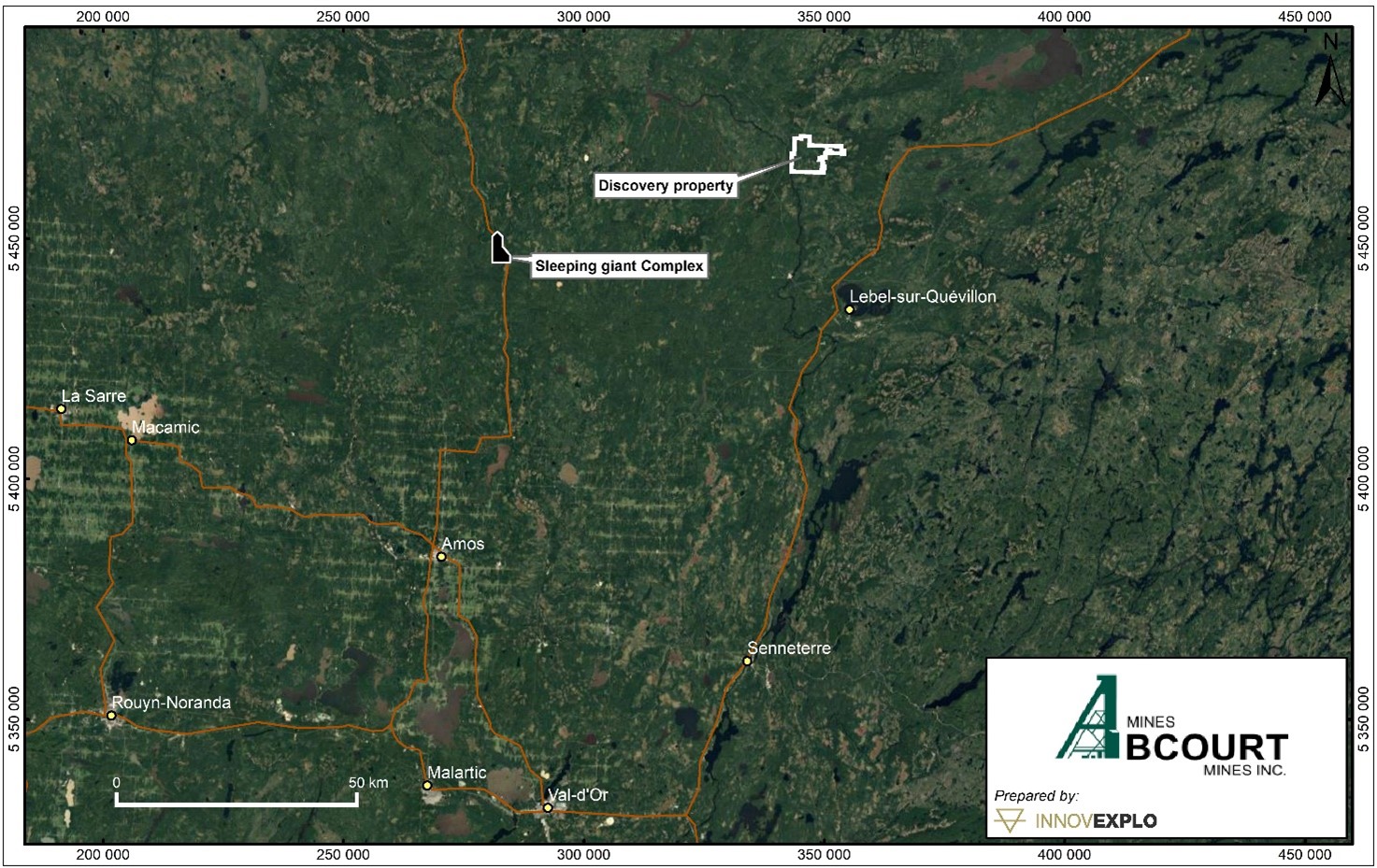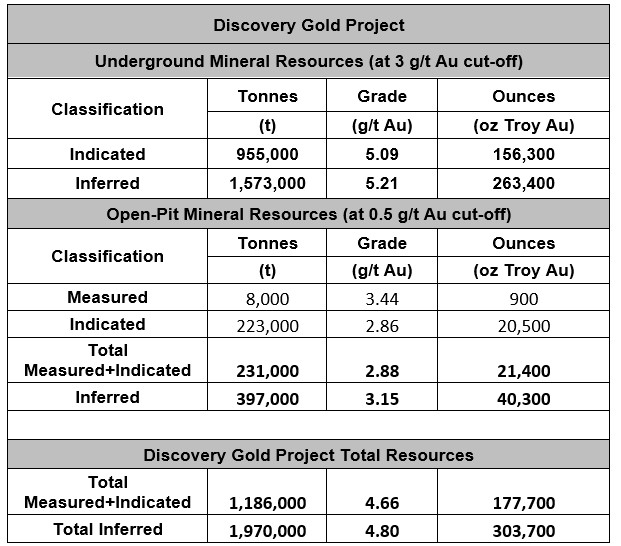Discovery property
The Discovery project has 166 claims with a total area of 4,166 hectares, 100% owned by Abcourt. The property is located about 30 km to the north-west of Lebel-sur-Quévillon, Québec. The gold at Discovery is found in quartz-carbonate veins in a deformed and metamorphosed gabbro. The latest calculation of historical resources was made by InnovExplo in 2008. A significant gold mineralization is indicated. As these resources are not considered current by Abcourt, the Company is therefore prohibited under Canadian securities regulations to publish them.
During the 2018 fall, Abcourt has completed a drilling campain on the Discovery and Flordin properties (respectively 12 holes for 2,742 meters and 5 holes for 921 meters. The main results of these drilled are provided in the press release issued by the Company on March 20, 2019.
Figure 1 : Regional Map

This MRE reflects the results of approximately 158 thousand metres of drilling, of which 35,551 metres were carried out from 2010 to 2018. The MRE was carried out by the firm InnovExplo of Val d’Or.
Highlights
– 177,700 ounces of Measured and Indicated Resources in 1,186,000 tonnes at an average grade of 4.66 g/t Au;
– 303,700 ounces of Inferred Resources in 1,900,700 tonnes at an average grade of 4.80 g/t Au;
– This MRE will serve as a basis for carrying out an exploration campaign with the aim of exploring the extensions of the deposit and potentially increasing the mineral resources.
Pascal Hamelin, President and CEO of Abcourt, said: “We are pleased to now own a second deposit with mineral resources near our Sleeping Giant Mill. The potential for a regional hub around the Sleeping Giant Mill is beginning to emerge with the addition of the Discovery deposit, and the upcoming addition of another MRE at the Flordin deposit within the same radius around the Mill. »
Figure 2: Longitudinal View of the Discovery deposit

Table 1: Mineral Resources Estimate of the Discovery Gold Project

Notes to the 2023 MRE
- The effective date of the 2023 MRE is March 28, 2023.
- The independent and qualified persons (as defined by NI 43-101) for the 2023 MRE are Olivier Vadnais-Leblanc, P.Geo., Simon Boudreau, P.Eng.,and Eric Lecomte, P.Eng. from InnovExplo Inc,
- The mineral resource estimate conforms to the CIM Definition Standards (2014) and follows the CIM MRMR Best Practice Guidelines (2019).
- These mineral resources are not mineral reserves, because they do not have demonstrated economic viability. The results are presented undiluted and are considered to have reasonable prospects of economic viability.
- The estimate encompasses 34 mineralized solids developed using LeapFrog Geo.
- 1 m composites were calculated within the mineralized zones using the grade of the adjacent material when assayed or a value of zero when not assayed. High-grade capping supported by statistical analysis was done on composites and was set to 35 g/t Au.
- The estimate was completed using a sub-block model in Leapfrog Edge. A 16m x 1m x 16m (X,Y,Z) parent block size and a 4m x 1m x 4m (X,Y,Z) sub block size was used.
- Grade interpolation was obtained by Inverse Distance Squared (ID2) using hard boundaries.
- A density value of 2.82 g/cm3 was assigned to all mineralized zones.
- Measured resources are defined inside a distance of 8m from an underground or surface channel within existing indicated resources. Indicated resources are defined with a minimum of two (2) drill holes within the areas where the drill spacing is less than 50m. The Inferred category is defined with a (1) drill holes within the areas where the drill spacing is less than 150 m. Data must show reasonable geological and grade continuity.
- The Underground 2023 MRE is locally constrained within Deswik Stope Optimizer shapes using a minimal mining width of 1.7 m for a potential Long-Hole underground mining method (potential block of 16m X 16m), with no maximum width. It is reported at a rounded cut-off grade of 3 g/t Au using the long-hole mining method. The open pit 2023 MRE is locally constrained within Whittle surfaces using a rounded cut-off grade of 0.5 g/t Au. The cut-off grades were calculated using the following parameters: mining cost Open Pit = C$4.65/t; mining cost Underground= C$169.50/t; processing cost = C$21.50/t; G&A = C$12.00/t; selling costs = C$5.00/oz; gold price = US$1,650.00/oz; USD:CAD exchange rate = 1.33; and mill recovery = 96.0%. The cut-off grades should be re-evaluated considering future prevailing market conditions (metal prices, exchange rates, mining costs etc.).
- Mineral resources were classified into measured, indicated or inferred. The measured category is define as an indicated resources contains within an 8 metres radius from surface or underground channels sampling. Indicated resources are defined by being interpolated using a minimum of two (2) DDH within a 50 metres radius. Inferred resources are defined by being interpolated with one (1) DDH within a 150 metres radius, all where there is reasonable geological and grade continuity.
- The number of metric tonnes was rounded to the nearest thousand, following the recommendations in NI 43-101 and any discrepancies in the totals are due to rounding effects. The metal contents are presented in troy ounces (tonnes x grade / 31.10348) rounded to the nearest hundred. Numbers may not add up due to rounding.
- The independent and qualified persons for the 2023 MRE are not aware of any known environmental, permitting, legal, political, title-related, taxation, socio-political, or marketing issues that could materially affect the Mineral Resource Estimate.
This MRE adheres to current Canadian standards for the disclosure of mineral resources and reserves as created by the Canadian Institute of Mining (“CIM”) and defined in the CIM Definition Standards for Mineral Resources and Mineral Reserves dated May 2014 (“ICM Definition Standards”). The MRE also complies with the CIM Best Practice Guidance on Estimating Mineral Resources and Mineral Reserves dated November 2019 (“CIM MRMR Best Practice Guidance”).
This MRE includes the amalgamation of blocks of various grades (“mandatory blocks”) included within potential mining forms respecting the reasonable prospect of eventual economic extraction, as specified by the CIM in 2019.


